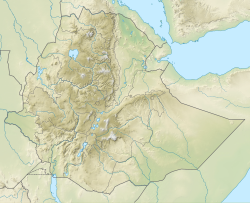| Adigrat Sandstone | |
|---|---|
| Stratigraphic range: | |
 Dabba Selama monastery in Dogu’a Tembien, established on a mesa in Adigrat Sandstone – one of the most inaccessible monasteries in the world[1] | |
| Type | Geological formation |
| Underlies | Antalo Limestone |
| Overlies | Enticho Sandstone, Edaga Arbi Glacials, Fincha Sandstone |
| Thickness | 600 m (2,000 ft) |
| Lithology | |
| Primary | Sandstone |
| Other | Siltstone, Claystone, Dolomite |
| Location | |
| Coordinates | 14°10′51″N 39°28′31″E / 14.1808°N 39.4752°E |
| Region | Tigray |
| Country | |
| Extent | Eritrea, Tigray |
| Type section | |
| Named for | Town of Adigrat |
| Named by | William Thomas Blanford |
The Adigrat Sandstone formation in north Ethiopia, in a wide array of reddish colours, comprises sandstones with coarse to fine grains, and locally conglomerates, silt- and claystones. Given the many lateritic palaeosols and locally fossil wood fragments, the formation is interpreted as a deposit in estuarine, lacustrine-deltaic or continental environments. The upper limit of Adigrat Sandstone is of Middle-Late Jurassic age (around 160 million years or Ma ago) whereas the lower boundary is Triassic (200 Ma).[2][3] There are numerous rock-hewn churches in this formation.
- ^ Nyssen, Jan (2019). Description of Trekking Routes in Dogu'a Tembien. GeoGuide. pp. 557–675. doi:10.1007/978-3-030-04955-3_38. ISBN 978-3-030-04954-6.
- ^ Sembroni, A.; Molin, P.; Dramis, F. (2019). Regional geology of the Dogu'a Tembien massif. In: Geo-trekking in Ethiopia's Tropical Mountains - The Dogu'a Tembien District. SpringerNature. ISBN 978-3-030-04954-6.
- ^ Beyth, M. (1972). To the Geology of Central-Western Tigre. Bonn: Dissertation Rheinische Friedrichs-Wilhelms-Universität Bonn. p. 159.
